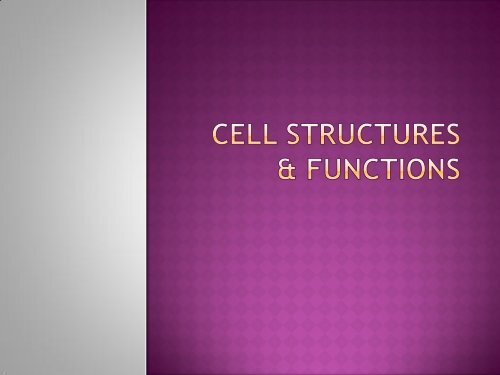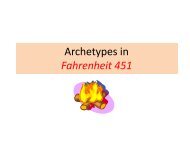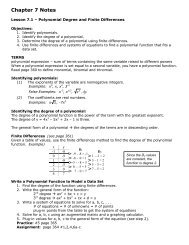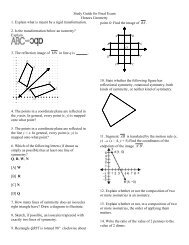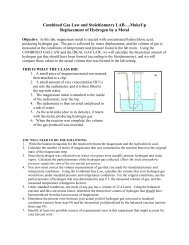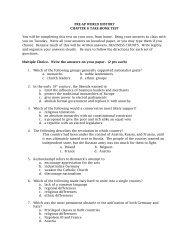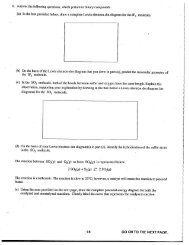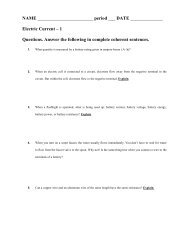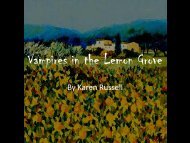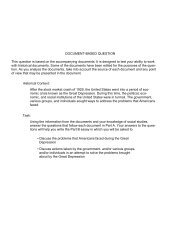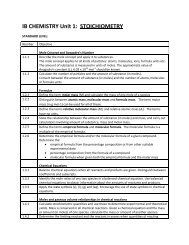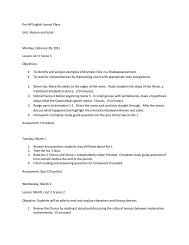Ch. 7 Cell Organelles, Structure and Function
Ch. 7 Cell Organelles, Structure and Function
Ch. 7 Cell Organelles, Structure and Function
Create successful ePaper yourself
Turn your PDF publications into a flip-book with our unique Google optimized e-Paper software.
The first cells [“pro”]<br />
No membrane bound organelles
The first true [“eu”] cells<br />
Contains membrane-bound organelles
All living things are made of cells.<br />
<strong>Cell</strong>s are the basic units of structure <strong>and</strong><br />
function in living things.<br />
New cells are produced from existing cells.
Means “little organs”<br />
Membrane-bound structures inside a cell that<br />
perform a specific function.<br />
You can practice identifying organelles <strong>and</strong> functions at:<br />
http://www.cellsalive.com/cells/cell_model.htm<br />
NO organelles<br />
organelles
<strong>Cell</strong> type/Location: all cells/surrounds the cell.<br />
<strong>Structure</strong>: semipermeable lipid bilayer; proteins<br />
embedded into membrane<br />
<strong>Function</strong>: cell identification (proteins), monitors<br />
what goes in <strong>and</strong> out of cells to help MAINTAIN<br />
HOMEOSTASIS
<strong>Cell</strong> Type/Location: only<br />
plant, fungi & bacteria –<br />
surrounds the plasma<br />
membrane<br />
<strong>Structure</strong>: plants: cellulose,<br />
bacteria: petidoglycan,<br />
fungi: chitin<br />
<strong>Function</strong>: structure &<br />
support.<br />
(allows plants the structure to<br />
grow up towards the sun.)<br />
<strong>Cell</strong> wall<br />
(transparent)
<strong>Cell</strong> Type/Location: only eukaryotes/center of the<br />
cell<br />
<strong>Structure</strong>: surrounded by a nuclear envelope.<br />
Things pass in <strong>and</strong> out through nuclear pores<br />
<strong>Function</strong>: controls most cell processes & contains<br />
the hereditary info in the form of DNA
<strong>Cell</strong> Type/Location: only eukaryotes/inside nucleus<br />
<strong>Structure</strong>: small, dense region inside nucleus<br />
<strong>Function</strong>: assembles ribosomes<br />
Nucleolus
Location: inside nucleus<br />
<strong>Structure</strong>: DNA is coiled around proteins <strong>and</strong> is in a<br />
“relaxed” state. <strong>Ch</strong>romatin will condense into<br />
chromosomes right before cell division occurs.<br />
<strong>Function</strong>: holds instructions for making proteins.
Location: throughout cytoplasm. In eukaryotes, it is<br />
“free” <strong>and</strong> attached to endoplasmic reticulum.<br />
<strong>Structure</strong>: made of “ribosomal RNA” & proteins. Is NOT a<br />
membrane-bound organelle.<br />
<strong>Function</strong>: proteins are assembled at ribosomes.<br />
Ribosomes on ER make proteins for cell membrane or<br />
export. “Free” ribosomes make other cellular proteins.
Location: Fluid-like matrix that fills the inside<br />
of the cell. Includes EVERYTHING (organelles &<br />
“jelly”) except the membrane <strong>and</strong> the nucleus.<br />
3 functions are performed here: food is<br />
converted into energy, energy is stored,<br />
substances are manufactured.
Location: cytoplasm<br />
<strong>Structure</strong>: system of highly folded membranes.<br />
ROUGH ER function: modifies proteins made in<br />
the ribosomes.<br />
SMOOTH ER function: assembles lipid<br />
components of the cell membrane. Can be<br />
involved in detox of drugs. (liver cells often<br />
contain lots of smooth ER)
Location: cytoplasm<br />
<strong>Structure</strong>: stack of closely opposed membranes<br />
(stack of pancakes)<br />
<strong>Function</strong>: modifies, sorts, <strong>and</strong> packages proteins<br />
for storage inside the cell or export out of the<br />
cell.
Location: cytoplasm – very large central vacuole<br />
in plants<br />
<strong>Structure</strong>: saclike structure<br />
<strong>Function</strong>: used to store materials such as water,<br />
salts, proteins, <strong>and</strong> carb’s.
Location: cytoplasm<br />
<strong>Structure</strong>: small organelles filled with enzymes<br />
<strong>Function</strong>: enzymes are used to break down<br />
lipids, carb’s <strong>and</strong> proteins for use in the cell.<br />
Lysosomes are also involved in breaking down old<br />
or foreign substances.<br />
“garbage man”
Location: cytoplasm of all cells, including<br />
plants.<br />
<strong>Structure</strong>: 2 membranes, outer membrane <strong>and</strong><br />
inner folded membrane (kristae)<br />
<strong>Function</strong>: breaks down glucose to make ATP<br />
during cellular respiration. ATP can then be used<br />
to fuel cell processes.
<strong>Cell</strong> Type/Location: ONLY in cytoplasm of PLANTS & other<br />
photosynthetic organisms.<br />
<strong>Structure</strong>: two membranes – outer membrane <strong>and</strong> inner<br />
system of folded membranes, called the thylakoid<br />
membranes.<br />
<strong>Function</strong>: makes glucose during photosynthesis.
Mitochondria & chloroplasts contain their own<br />
DNA.<br />
Mitochondria are only found in the egg – so there<br />
has been no genetic recombination of DNA as it<br />
is passed through the generations.<br />
Theory – mitochondria & chloroplasts may have<br />
evolved from independent prokaryotes that<br />
developed symbiotic relationships with early<br />
prokaryotes.
Location: cytoplasm<br />
<strong>Structure</strong>: system of thin fibers – network of protein<br />
filaments<br />
<strong>Function</strong>: like scaffolding – supports the cell <strong>and</strong> maintains<br />
shape. It is also involved in movement (amoebas or<br />
transporting materials within the cell)
Small, dark bodies found at right angles to<br />
each other just outside the nucleus<br />
They play an important role in cell division.
Location: outside the cell<br />
<strong>Structure</strong>: both are made of the same type of<br />
protein. Cilia – short, hairlike projections.<br />
Flagella – long, whiplike extensions.<br />
<strong>Function</strong>: movement & feeding
A. Producing proteins<br />
B. Packaging substances for export from<br />
the cell<br />
C. Doing cellular respiration<br />
D. Controlling cell activities
A. ribosomes<br />
B. chloroplast<br />
C. nucleus<br />
D. centrioles
A. Protein production<br />
B. Lipid synthesis<br />
C. <strong>Cell</strong> division<br />
D. <strong>Cell</strong> structure


